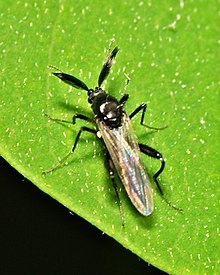And then we have those pesky no-see-ums..man, I hate those fuckers. I have been bit for the last time...I hope.
Ceratopogonidae
From Wikipedia, the free encyclopedia
| Ceratopogonidae | |
|---|---|
 |
|
| A female biting midge, Culicoides sonorensis | |
| Scientific classification | |
| Kingdom: | Animalia |
| Phylum: | Arthropoda |
| Class: | Insecta |
| Order: | Diptera |
| Suborder: | Nematocera |
| Infraorder: | Culicomorpha |
| Superfamily: | Chironomoidea |
| Family: | Ceratopogonidae |
| Subfamilies | |
| Forcipomyiinae Dasyheleinae Ceratopogoninae Leptoconopinae |
|
They are found in almost any aquatic or semiaquatic habitat throughout the world. Females of most species are adapted to suck blood from some kind of host animal. Culicoides, Forcipomyia (Lasiohelea), and Leptoconops suck vertebrate blood. Some Atrichopogon and Forcipomyia are ectoparasites on larger insects. Dasyhelea feed exclusively on nectar. Species in other genera are predatory on other small insects. Larvae are always found in some damp location, such as under bark, in rotten wood, compost, mud, stream margins, tree holes, or water-holding plants (i.e., phytotelmata).
Many of the hematophagic (blood-eating) species are pests in beach or mountain habitats. Some other species are important pollinators of tropical crops such as cacao. The blood-sucking species may be vectors of disease-causing viruses, protozoa, and filarial worms. The bite of midges in the genus Culicoides causes an allergic response in equines known as sweet itch. In humans, their bite can cause intensely itchy, red welts that can persist for more than a week. The discomfort arises from a localized allergic reaction to the proteins in their saliva, which can be somewhat alleviated by topical antihistamines.
The smaller members of the family are tiny enough to pass through the apertures in typical window screens. Camping tents are often equipped with extra-fine mesh netting, called no-see-um nets, to keep the pests out.
Finally broke down and bought a roll of No-See-Um screen. Bought it at Home Depot in Prince George...$62.00 for 25 feet. I have enough to do mine maybe...6 times. I don't care, as long as it works.
It actually went better than I had anticipated. So..if you are tired of being bitten by those small little mothers...maybe you might consider? I really found the price exorbitant, compared to standard screen material..and why 25 feet? I guess they marketing to people with cabins. Still, they could have sold it in smaller amounts...they'd sell more.
To test the new screens, we went off last night..at 9 pm....up a logging road. I mean...what else are you goig to do after having supper in a bar?
Coming out, we had to wait a sec.....








Gary - do you still get a breeze through the screening? I read a blog where the woman was using vanilla extract mixed with water , spritzed on. It's supposed to work for mosquito. Also Listerine , the original kind. So you can smell like cookies or mouthwash but at least you don't get bit! :D We've been lucky -no bugs at all this year.
ReplyDeleteHi Karen...although the new screen is definitely thicker/tougher, I still get a breeze. If it's warm-ish, I use the Fantastic fan to draw air thru and certainly when sleeping, leaving the bed window open and the fan on with the rheostat set...nice breeze!
ReplyDelete